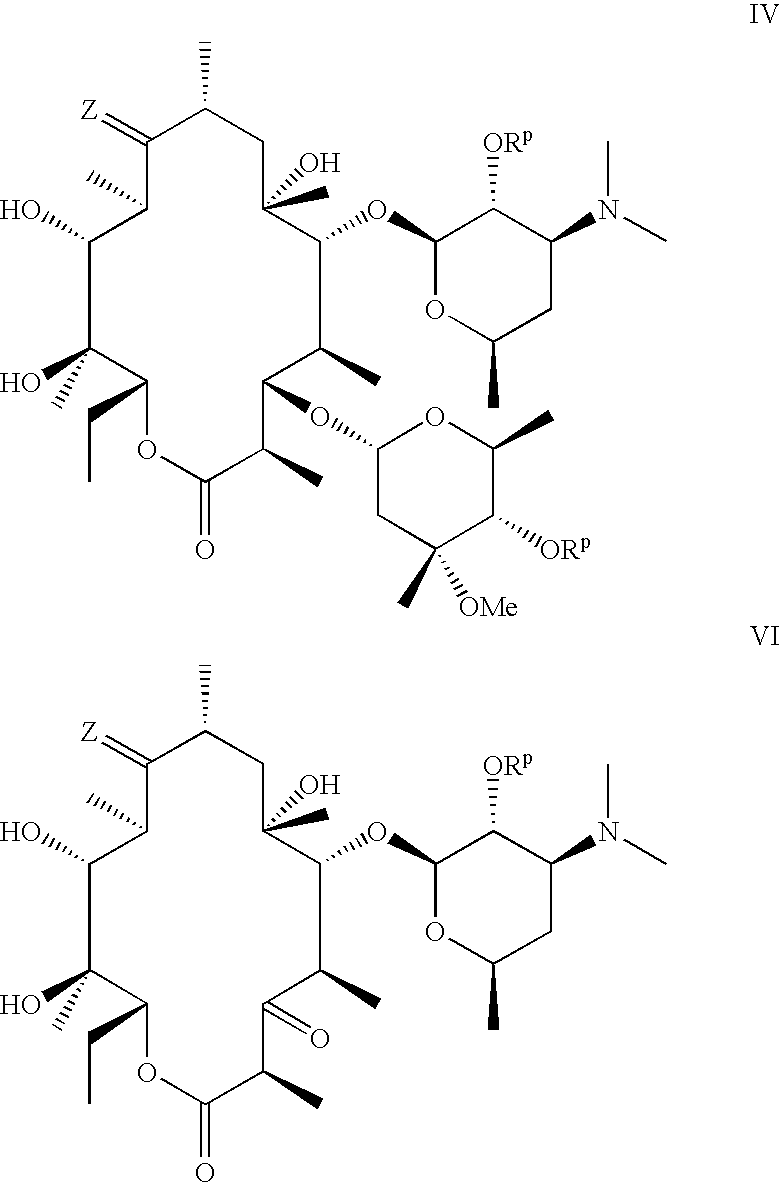Anti-infective agents useful against multidrug-resistant strains of bacteria
a technology of anti-infective agents and bacteria, which is applied in the field of anti-infective agents useful against multi-drug-resistant strains of bacteria, can solve problems such as no recognition or appreciation, and achieve the effect of inhibiting the activity and inhibiting the bacterial activity of staph
- Summary
- Abstract
- Description
- Claims
- Application Information
AI Technical Summary
Benefits of technology
Problems solved by technology
Method used
Image
Examples
example 1
Preparation of 6-O-[3-(3-quinolyl)-2-propen-1-yl]-3-descladinose-3-oxo-9-[(O-ethyl)oxime] Erythromycin A
Compound of formula III, wherein R1 is —CH2CH═CH(3-quinolyl), R2 is —CH2CH3 and Rp is hydrogen
Step (1): 6-O-[3-(3-Quinolyl)-2-propen-1-yl]-3-descladinose-3-oxo-2′-O-benzoyl Erythromycin A
[0139]The title compound was prepared in accordance with the methods described in U.S. Pat. No. 5,866,549, which is herein incorporated by reference, and in particular by the procedure described for Example 18, Step 18a.
Step (2): 6-O-[3-(3-Quinolyl)-2-propen-1-yl]-3-descladinose-3-oxo-2′-O-benzoyl-9-[(O-ethyl)oxime]Erythromycin A
[0140]To a stirred mixture of 6-O-[3-(3-quinolyl)-2-propen-1-yl]-3-descladinose-3-oxo-2′-O-benzoyl erythromycin A (0.84 g, 1.0 mmol) and O-ethylhydroxylamine hydrochloride (0.20 g, 2.0 mmol, 2.0 equiv) in ethanol (10 mL) was added camphor sulfonic acid (23 mg, 0.1 mmol, 0.1 equiv) at room temperature. The resulting mixture was degassed and warmed to 80° C. under nitrogen f...
examples 2-9
[0142]The following compounds were prepared according to the methods of Example 1, but substituting the amount (in molar equivalents) of the reagents named below for O-ethylhydroxylamine to obtain a compound of formula III wherein R2 is the functional group defined in Table 1.
[0143]
TABLE 1AmountExample #Reagent(equiv)R2MS (M + H)+ m / e2CH3ONH2.HCl377032812428465289163798738128NH2OH.HCl3—H78693958
example 10
6-O-Methyl-9-[(O-isobutyl)oxime] Erythromycin A
Compound of formula I, wherein R1 is —CH3, R2 is isobutyl, and R3 is hydroxy
Step (1): 6-O-Methyl Erythromycin A
[0144]The title compound was prepared in accordance with the methods described in U.S. Pat. No. 4,331,803, which is herein incorporated by reference, and in particular by the procedure described for Example 1.
Step (2): 6-O-Methyl-9-oxime Erythromycin A
[0145]To a stirred suspension of the 6-O-methyl erythromycin A (10.0 g, 13.4 mmol) in isopropyl alcohol was added 50% hydroxylamine (aq.) (8.8 g, 0.134 mol, 10.0 equiv), followed by acetic acid (3.5 g). The reaction mixture was stirred at ambient temperature over night after which time it was warmed to 50° C. After three days, the reaction appeared complete by TLC (SiO2, 0.5:10.0:89.5 NH4OH / MeOH / CH2Cl2). The reaction was allowed to cool to room temperature at which time it was diluted with isopropyl acetate. The mixture was made basic (to litmus) using 4 N NaOH thus precipitating ...
PUM
| Property | Measurement | Unit |
|---|---|---|
| temperature | aaaaa | aaaaa |
| temperature | aaaaa | aaaaa |
| temperature | aaaaa | aaaaa |
Abstract
Description
Claims
Application Information
 Login to View More
Login to View More - R&D
- Intellectual Property
- Life Sciences
- Materials
- Tech Scout
- Unparalleled Data Quality
- Higher Quality Content
- 60% Fewer Hallucinations
Browse by: Latest US Patents, China's latest patents, Technical Efficacy Thesaurus, Application Domain, Technology Topic, Popular Technical Reports.
© 2025 PatSnap. All rights reserved.Legal|Privacy policy|Modern Slavery Act Transparency Statement|Sitemap|About US| Contact US: help@patsnap.com



